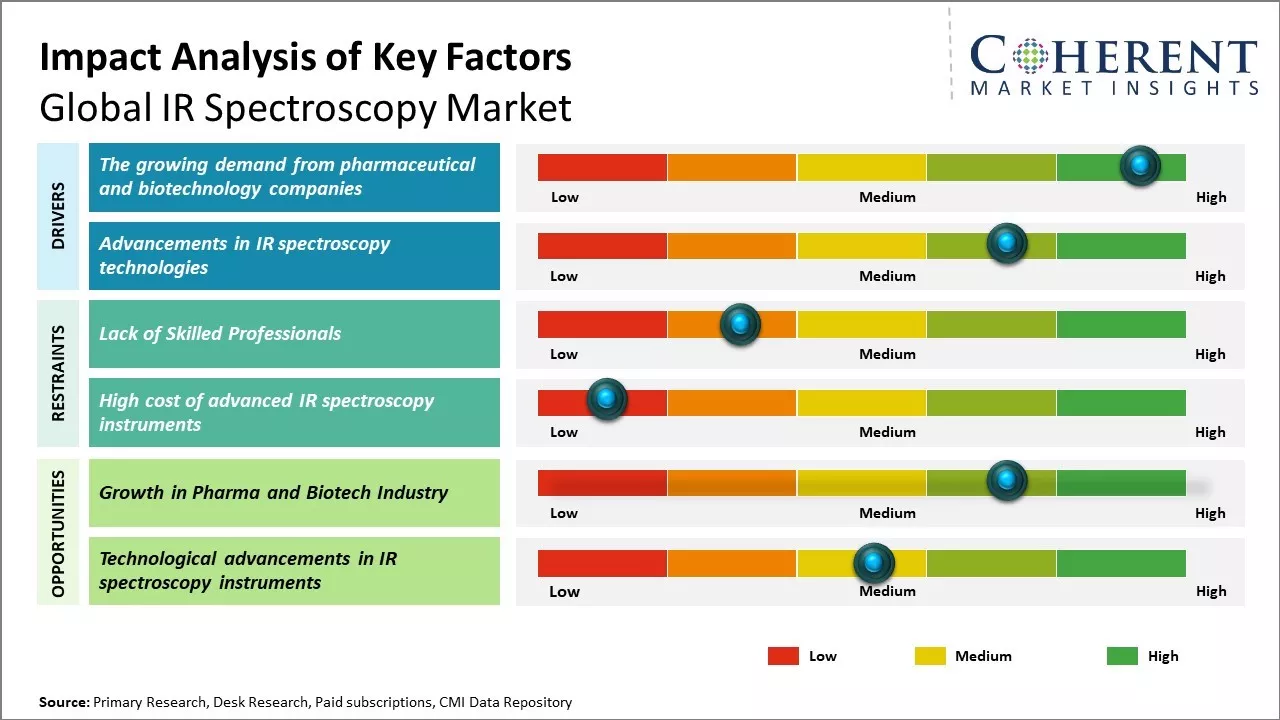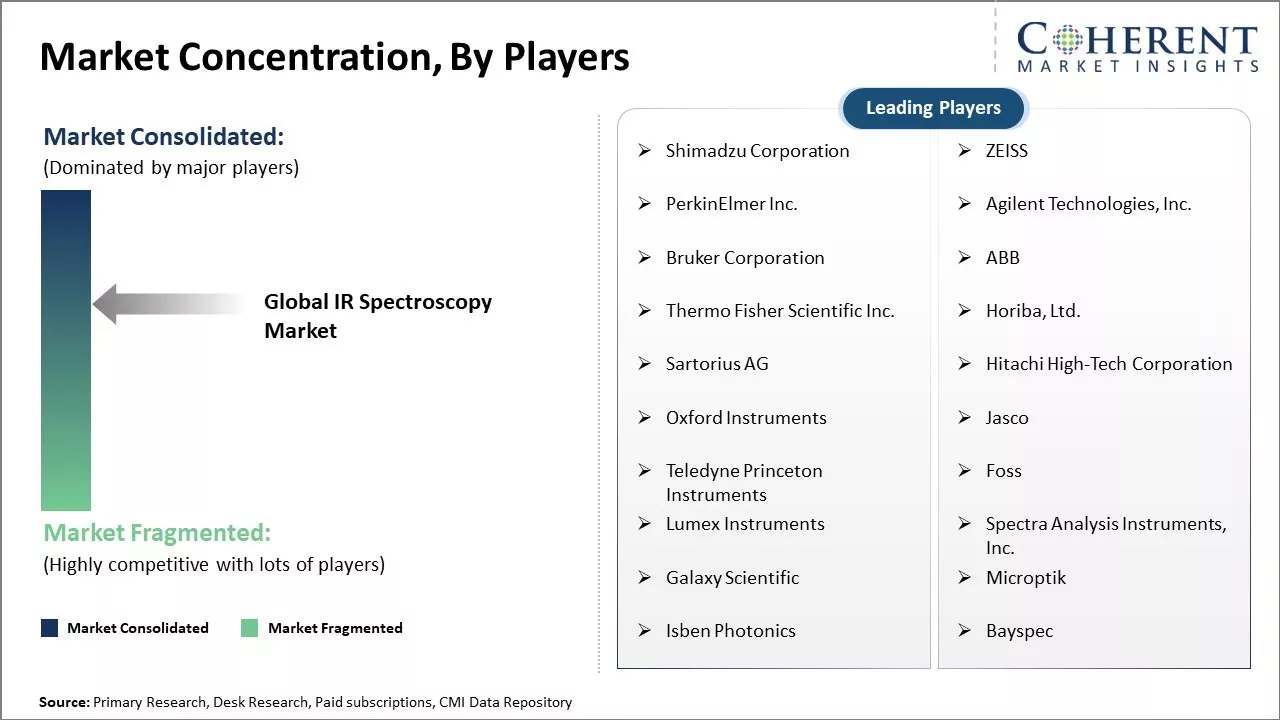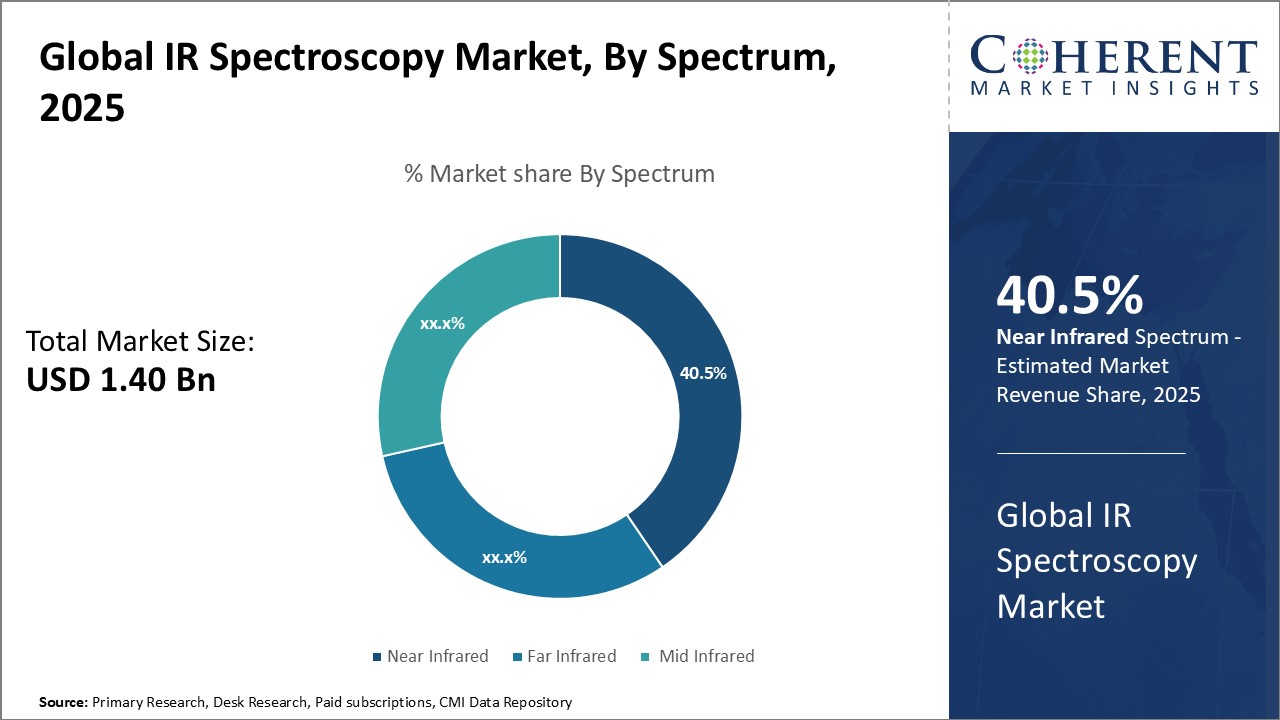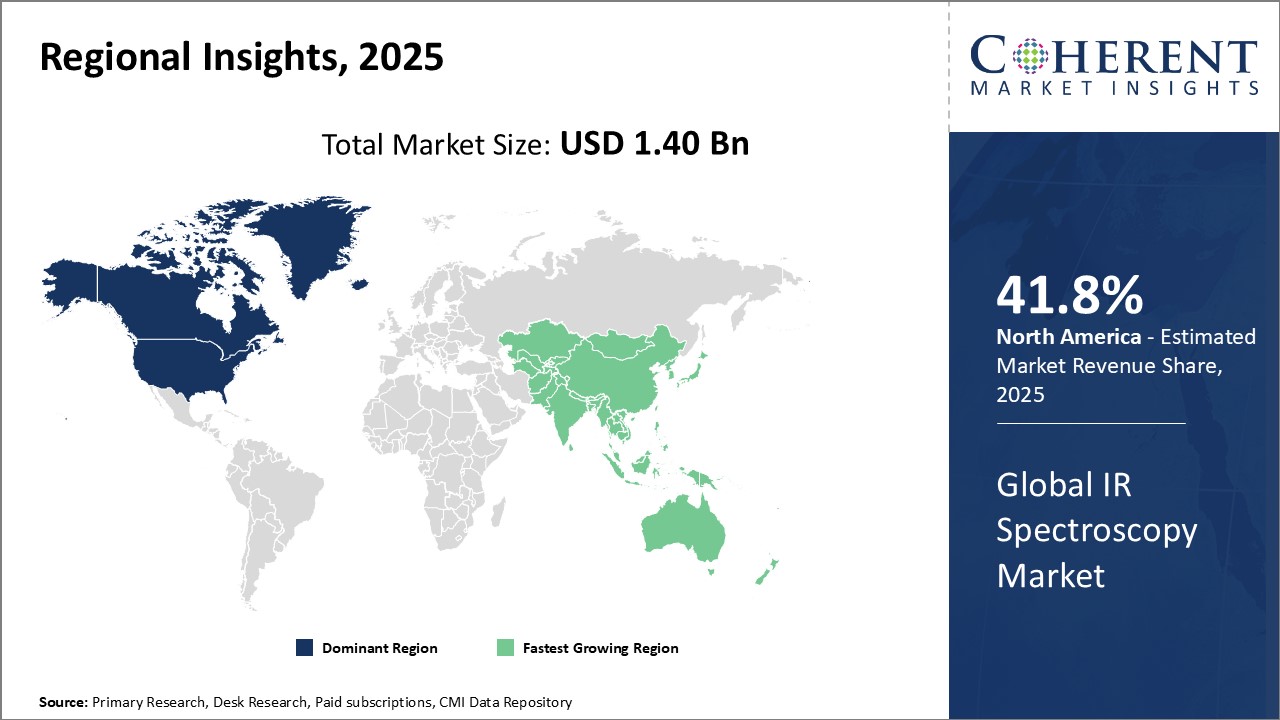Global IR Spectroscopy Market Size and Trends
The Global IR Spectroscopy Market is estimated to be valued at USD 1.40 Bn in 2025 and is expected to reach USD 2.29 Bn by 2032, exhibiting a compound annual growth rate (CAGR) of 7.3% from 2025 to 2032. The market is expected to witness significant growth over the forecast period owing to rising applications of IR spectroscopy techniques across various industries such as healthcare, semiconductors, oil and gas, and chemicals, among others.

Discover market dynamics shaping the industry: Download Free Sample
The global IR spectroscopy market trend shows growing demand for infrared spectroscopy instruments across various end-use industries. Technological advancements in IR spectroscopy instruments along with the miniaturization of spectrometers and integration of software tools are driving the overall market growth. Adoption of portable devices and incorporation of microfluidics are opening new growth avenues for players operating in this market.
The growing demand from pharmaceutical and biotechnology companies
The demand for IR spectroscopy from the pharmaceutical and biotechnology sector has been rising significantly over the past decade. The need for improved analytical capabilities during drug discovery and development processes has fueled the adoption of IR spectroscopy techniques. Pharmaceutical companies are under constant pressure to develop new drugs and bring them to market at a rapid pace to gain an edge over competitors. IR spectroscopy helps streamline various processes involved such as identifying functional groups in chemical structures, detecting polymorphic forms of drug compounds, characterizing complex biomolecules, and ensuring consistent quality of active ingredients and final drug products. Its non-destructive nature makes it very suitable for analysis of sensitive biological samples. Furthermore, strict quality control regulations imposed by authorities have prompted pharmaceutical manufacturers to heavily rely on spectroscopic methods for raw material testing and finished product quality assurance. IR spectroscopy allows for quick, reproducible and reliable analysis of chemical and phase purity of materials without destroying the sample structure. This has been a key factor contributing to its increased uptake. Going forward, as R&D expenses rise and competition intensifies in the pharmaceutical industry, the need for high-precision analytical tools like IR spectroscopy will only magnify.
Market Concentration and Competitive Landscape

Get actionable strategies to beat competition: Download Free Sample
Advancements in IR spectroscopy technologies
The IR spectroscopy market has witnessed tremendous technological innovations over the past decade. Manufacturers have developed new breeds of IR spectrometers with improved capabilities to address the evolving analytical needs. For instance, the integration of FT-IR with imaging microscopes has enabled mapping of chemical variations at micro and nanoscale levels. Systems combining IR spectroscopy with mass spectrometry have augmented molecular identification. Synchrotron-based IR techniques offer new insights by generating spectroscopic fingerprints of sample structures at an unprecedented resolution. Advances in detector technology have augmented sensitivity to parts-per-million or billion levels. Portable handheld devices have enabled on-site analysis, reducing turnaround time. Integration of IR instruments with lab automation solutions through software has streamlined workflows. Data processing has become more sophisticated with machine learning and artificial intelligence finding increased usage. Miniaturized IR chips promise decentralization of testing. Continued focus on developing quantum cascade lasers with broader wavelength coverage and higher output is further raising the analytical bar. The advent of such innovations has expanded IR applications into new domains like art preservation and archaeology. To gain competitive edge, manufacturers are continuously pumping investments in R&D to introduce upgraded product versions. This has certainly fueled demand from customers looking for advanced analytical solutions.
Key Takeaways from Analyst:
The rising adoption of IR spectroscopy techniques in oil and gas, food and beverages, pharmaceutical, and chemical industries for process optimization and quality control is a major factor driving the growth of the IR spectroscopy market. Vibrational spectroscopy helps in identifying unknown substances and detecting impurities which is fueling its demand across various end-use industries.
Another factor propelling the IR spectroscopy market is rising food safety concerns and stringent regulations regarding the quality and purity of food products. The highly accurate and non-destructive nature of IR spectroscopy makes it a popular analytical technique for authenticating food products. North America currently dominates the market owing to extensive research activities and presence of prominent manufacturers in the region. However, the Asia Pacific region is expected to offer lucrative growth opportunities during the forecast period attributed to growing foreign investments and cost-effectiveness of operations in the region.
The high cost of IR spectroscopy equipment and requirement of skilled labor for operation and data analysis can pose significant challenges to the growth of the market. However, continuous technological advancements in IR spectroscopy systems such as miniaturization, enhanced spectral range, and accuracy are expected to boost its adoption rate across various applications. Overall, the IR spectroscopy market is anticipated to grow steadily supported by increasing R&D spending and stringent quality control mandates across different industry verticals globally.
Market Challenges: Lack of Skilled Professionals
One of the key challenges currently being faced by the global IR spectroscopy market is the lack of availability of skilled professionals and labor force with expertise in operating complex IR spectroscopy instruments and analyzing the obtained spectral data. IR spectroscopy requires specialized technical know-how and training to handle sophisticated devices and interpret infrared spectra. However, there is a severe shortage of trained technicians and scientists familiar with advanced IR spectroscopy techniques like FT-IR, Near-IR, and Raman spectroscopy across major markets. This skill gap is hampering laboratory operations and R&D projects dependent on such analytical techniques. Furthermore, it is challenging for manufacturers to deploy new instruments and solutions in the market owing to lack of local support from trained local representatives. If the shortage of skilled workers is not addressed, it can negatively impact the adoption of novel IR spectroscopy technologies and expansion of related application areas.
Market Opportunities: Growth in Pharma and Biotech Industry
The global pharmaceutical and biotechnology industry has been witnessing steady growth over the past few decades driven by increasing investments in R&D and new drug development programs. IR spectroscopy has emerged as an invaluable analytical technique widely used across various phases of drug manufacturing and quality checks. It is being utilized for characterization of active pharmaceutical ingredients, detection of impurities, analysis of drug formulations, and quality testing. The biopharma industry’s increasing emphasis on process analytical technology adoption and in-line quality monitoring during manufacturing has further bolstered demand for portable and online IR spectroscopy systems. With robust pharma industry expansion projected in both developed and developing markets in the coming years, especially Asia-Pacific, it is expected to perpetually drive the requirement for sophisticated as well as affordable IR spectroscopy devices. This presents lucrative opportunities for spectroscopy product manufacturers to develop technologically advanced and customizable solutions catering to biotech analytical needs.

Discover high revenue pocket segments and roadmap to it: Download Free Sample
By Spectrum-Near Infrared dominants due to its wide applications
In terms of Spectrum, the Near Infrared segment is estimated to hold the highest share of 40.5% in 2025 owing to its wide range of applications across various industries. Near infrared spectroscopy enables non-destructive analysis and finds extensive usage in quality control and product development applications in industries like food, pharmaceuticals, polymers, and plastics. Its ability to detect chemical and physical properties of materials has led to its prevalence in fields such as fingerprint analysis, authentication of artwork and documents. Near infrared spectroscopy instruments are not only cost-effective compared to other techniques but also offer non-invasive testing which makes them suitable for in-line process monitoring. These advantages have boosted the adoption of near infrared spectroscopy across sectors.
By Product Type - Benchtop models lead due to convenience and portability
In terms of Product Type, the Benchtop IR Spectroscope segment is estimated to hold the highest share of 30.62% in 2025 owing to its portability and flexibility. Benchtop IR spectrometers are compact, affordable analytical tools preferred by research labs and educational institutes for convenience. Their small footprint and moderate price point make them viable for applications that require occasional usage. Additionally, benchtop models offer sufficient functionality for characterization needs without compromising on mobility. This has widened their coverage from quality control in production facilities to on-site testing in field surveys. The portable design of benchtop IR spectrometers has boosted their popularity compared to other product types.
By End User - Pharmaceutical industries drive growth due to regulatory needs
In terms of End User, the Biopharmaceutical Companies segment is estimated to hold the highest share of 40.8% in 2024 owing to stringent quality regulations. Pharmaceutical manufacturers rely heavily on IR spectroscopy for raw material identification and characterization during different stages of drug development and manufacturing. The technology helps ensure consistency in active ingredients and detect impurities as mandated by regulatory guidelines. Quality control of pharmaceutical intermediates and finished drugs also involves IR spectroscopy. Additionally, it is utilized for identifying polymorphic forms and understanding solid-state properties. With industries aiming to reduce recalls and adhere to compliance, there is increasing dependence on IR spectroscopy techniques. This has boosted growth prospects for spectroscopy vendors catering to pharmaceutical customers.
Regional Insights

Need a Different Region or Segment? Download Free Sample
North America has traditionally been the dominant region in the global IR spectroscopy market with share of 41.8% in 2025.This can be attributed to the strong presence of leading IR spectroscopy manufacturers such as Thermo Fisher Scientific Inc. and Agilent Technologies, Inc. in the U.S. These companies have established vast distribution and service networks across the region to effectively cater to the demands of the end users. In addition, the region is home to top research institutions that are early adopters of advanced analytical techniques like IR spectroscopy. This has ensured a stable demand for various IR spectroscopy instruments such as FT-IR, Near-IR, and UV-Vis spectrometers in industries as well as academia.
However, over the past few years, the Asia Pacific region has emerged as the fastest growing market for IR spectroscopy globally. This growth can be attributed to increasing R&D investments by governments as well as private players across developing countries like China and India. Both the countries have witnessed exponential growth in their generic pharmaceutical manufacturing capabilities. This has created substantial demand for process analytical technology and quality control equipment like IR spectrometers. At the same time, growth in power, oil & gas and semiconductor industries has also fueled the sales of IR spectroscopy instruments in the region. Additionally, lower manufacturing and operating costs make IR spectroscopy solutions comparatively affordable for end-users in Asia Pacific. This has encouraged higher adoption of these analytical techniques even in price-sensitive applications.
Market Report Scope
Global IR Spectroscopy Market Report Coverage
| Report Coverage | Details | ||
|---|---|---|---|
| Base Year: | 2024 | Market Size in 2025: | USD 1.40 Bn |
| Historical Data for: | 2020 To 2024 | Forecast Period: | 2025 To 2032 |
| Forecast Period 2025 to 2032 CAGR: | 7.3% | 2032 Value Projection: | USD 2.29 Bn |
| Geographies covered: |
|
||
| Segments covered: |
|
||
| Companies covered: |
Shimadzu Corporation, ZEISS, PerkinElmer Inc., Agilent Technologies, Inc., Bruker Corporation, ABB, Thermo Fisher Scientific Inc., Horiba, Ltd., Sartorius AG, Hitachi High-Tech Corporation, Oxford Instruments, Jasco, Teledyne Princeton Instruments, Foss, Lumex Instruments, Spectra Analysis Instruments, Inc., Galaxy Scientific, Microptik, Isben Photonics, and Bayspec |
||
| Growth Drivers: |
|
||
| Restraints & Challenges: |
|
||
Uncover macros and micros vetted on 75+ parameters: Get instant access to report
Global IR Spectroscopy Industry News
- In November 2023, Wiley, a leading global publisher in research and learning, launched the Wiley Database of Predicted IR Spectra. This new resource integrates over 60 years of IR spectroscopy expertise and data curation with advanced machine-learning techniques, significantly expanding the available IR spectral data for analysis.
- In July 2023, Bruker Optics introduced the MOBILE-IR II, a lightweight, rechargeable FT-IR spectrometer that offers laboratory-grade spectral performance. This portable device allows users worldwide to conduct both standard and specialized FT-IR applications in the field, transforming spectroscopic analysis beyond traditional lab settings.
- In August 2022, Shimadzu Europe released the IRXross, a mid-level FTIR spectrophotometer known for its outstanding signal-to-noise ratio, ease of use, rapid measurement speed, and high resolution. This instrument delivers superior performance, addressing a wide range of analytical needs with exceptional efficiency.
- In February 2022, ABB announced that its MB3600 Fourier transform NIR spectrometer for cement raw material testing would be funded by China’s National Natural Science Foundation. This initiative supports market expansion with a single product across various sectors, optimizing resource use and boosting competitiveness.
- In September 2020, Bruker Corporation acquired Canopy Biosciences, LLC, a leader in high multiplex biomarker imaging for immuno-oncology, immunology, and cell therapy. This acquisition enhances Bruker's portfolio in multi-omics and fluorescence-based imaging technologies, strengthening its role in advanced life science research and diagnostics.
*Definition: The Global IR Spectroscopy Market involves the study and analysis of the infrared region of the electromagnetic spectrum to examine materials based on the fact that molecules absorb specific frequencies that are characteristic of their structure. IR spectroscopy allows identification of chemicals, determination of the composition of solids and liquids, and can detect impurities. The Global IR Spectroscopy Market includes manufacturers, application industries and suppliers of IR spectroscopy instruments, software and accessories on a global scale.
Market Segmentation
- Spectrum Insights (Revenue, USD Bn, 2020 - 2032)
- Near Infrared
- Far Infrared
- Mid Infrared
- Product Type Insights (Revenue, USD Bn, 2020 - 2032)
- Benchtop IR Spectroscope
- IR Microscopy
- Portable IR Spectroscope
- Hyphenated IR Spectroscope
- Terahertz IR Spectroscope
- End User Insights (Revenue, USD Bn, 2020 - 2032)
- Biopharmaceutical Companies
- Academic and research Institutes
- Others
- Regional Insights (Revenue, USD Bn, 2020 - 2032)
- North America
- U.S.
- Canada
- Latin America
- Brazil
- Argentina
- Mexico
- Rest of Latin America
- Europe
- Germany
- U.K.
- Spain
- France
- Italy
- Russia
- Rest of Europe
- Asia Pacific
- China
- India
- Japan
- Australia
- South Korea
- ASEAN
- Rest of Asia Pacific
- Middle East
- GCC Countries
- Israel
- Rest of Middle East
- Africa
- South Africa
- North Africa
- Central Africa
- North America
- Key Players Insights
- Shimadzu Corporation
- ZEISS
- PerkinElmer Inc.
- Agilent Technologies, Inc.
- Bruker Corporation
- ABB
- Thermo Fisher Scientific Inc.
- Horiba, Ltd.
- Sartorius AG
- Hitachi High-Tech Corporation
- Oxford Instruments
- Jasco
- Teledyne Princeton Instruments
- Foss
- Lumex Instruments
- Spectra Analysis Instruments, Inc.
- Galaxy Scientific
- Microptik
- Isben Photonics
- Bayspec
Share
Share
About Author
Komal Dighe is a Management Consultant with over 8 years of experience in market research and consulting. She excels in managing and delivering high-quality insights and solutions in Health-tech Consulting reports. Her expertise encompasses conducting both primary and secondary research, effectively addressing client requirements, and excelling in market estimation and forecast. Her comprehensive approach ensures that clients receive thorough and accurate analyses, enabling them to make informed decisions and capitalize on market opportunities.
Missing comfort of reading report in your local language? Find your preferred language :
Transform your Strategy with Exclusive Trending Reports :
Frequently Asked Questions
EXISTING CLIENTELE
Joining thousands of companies around the world committed to making the Excellent Business Solutions.
View All Our Clients
